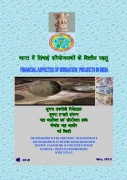/regions/political
Political
Water management in the Vijaynagar empire - Paper presented at the National Seminar on Water and Culture (2007)
Posted on 14 Feb, 2011 01:55 AMThis paper focuses on water management techniques used in two tanks constructed by the kings of the Vijaynagar Empire.
The first example taken, is that of the Anantraj Sagar built by the son of the minister of Harihar. The lake is still in use and there are inscriptions on stone near it which provide a thumb rule to constructing lakes. Construction of this lake began in 1369 and was completed in 2 years. The paper states that the length of the dam was 5000 dand, width was 8 dand and the height was 7 dand (One dand is about one metre).
Water management systems in the coastal area of Ratnagiri, with special reference to water tanks near temples - Paper presented at the National Seminar on Water and Culture (2007)
Posted on 14 Feb, 2011 01:27 AMThis paper discusses the water management systems found in temples in coastal Konkan, based on a study of 5 temples in the district of Ratnagiri. The study area is a rocky and rugged country, with elevated plateau and intersecting creeks.

Groundwater assessment using remote sensing data - A case study of the Bhadra river basin - Paper presented at the National Seminar on Water and Culture (2007)
Posted on 13 Feb, 2011 11:21 PMThis method is a mathematical model, in which all the components in the water balance equation are known, and the only component which is considered unknown is the rainfall recharge.
Idol immersion activities and their management in water bodies in India - Paper presented at the National Seminar on Water and Culture (2007)
Posted on 13 Feb, 2011 11:07 PMThis paper begins with an analysis of the rationale for idol immersion in Hinduism. Some of the reasons given by the author include water being able to disintegrate idols, the idea of purity of water etc.
Irrigation in India - Management phases and its sustainability - Paper presented at the National Seminar on Water and Culture (2007)
Posted on 13 Feb, 2011 10:52 PMSince time immemorial water has been a common property and in many Indian communities there is deep reverence for flowing water. Using the flow of water for community benefit is considered an act of great merit and its misuse and contamination, a sin. In temples, tanks were constructed for rituals and also as a way to earn money for the temple.
Seasonal prediction of the Indian monsoon – An assessment using atmospheric general circulation models (AGCMs) - An article from Current Science
Posted on 13 Feb, 2011 03:57 PMThe project was a collaborative effort of the coordinators and scientists from the different modelling groups across the country. All the runs were made at the Centre for Development of Advanced Computing (CDAC) at Bangalore on the PARAM Padma supercomputing system.
Prediction of the Indian summer monsoon rainfall using a state-of-the-art coupled ocean–atmosphere model - An article from Current Science
Posted on 13 Feb, 2011 03:04 PMA model of the coupled ocean–atmosphere system, the climate forecast system (CFS), from the National Centre for Environmental Prediction (NCEP), USA, has been ported onto the PARAM Padma parallel computing system at the Centre for Development of Advanced Computing (CDAC), Bangalore and retrospective predictions for the summer monsoon (June–September) season of 2009 have been generated, using five initial conditions for the atmosphere and one initial condition for the ocean for May 2009.
Non-compliance of dam agencies in construction of hydro-electric projects in Himachal Pradesh - A photo-essay by SANDRP
Posted on 13 Feb, 2011 03:02 PM
Download the photo essay:
Financial aspects of irrigation projects in India – A report by the Central Water Commission
Posted on 13 Feb, 2011 08:28 AM This publication by the Central Water Commission presents data on Major and Medium Irrigation and Multipurpose projects, Minor Irrigation projects, Command Area Development scheme as available in the Finance A
This publication by the Central Water Commission presents data on Major and Medium Irrigation and Multipurpose projects, Minor Irrigation projects, Command Area Development scheme as available in the Finance A
State Forest Policy of Jammu and Kashmir (2010)
Posted on 12 Feb, 2011 08:33 PMIn the backdrop of the essential need for maintaining a healthy forest resource, the valid concern for its continued depletion and degradation, and, being aware of the close association between people and forests, the Forest Department (Government of Jammu and Kashmir), has recently adopted a Forest Policy.